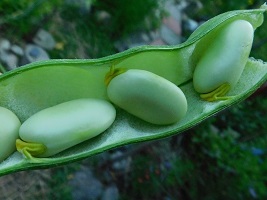
Great news about the discovery of a crucial gene responsible for a type of anaemia from eating faba beans, in a project led by Professor Donal O’Sullivan.
In work published in Nature Plants, an international team of scientists have identified the gene responsible for the production of vicine and convicine in the beans, also known as faba beans.
These anti-nutrients are responsible for favism – a form of anaemia in which red blood cells are damaged after people who are susceptible to the condition eat a large portion of uncooked faba beans.
The team found that the VC1 gene present in faba beans is required for the production vicine and convicine, and have also identified a specific mutation within this gene that causes the significant reduction in synthesis of the compounds.
They found that all faba bean varieties with a low vicine-convicine content had two nucleotides – the ’letters’ that make up DNA – inserted within the VC1 gene. This insertion disrupts VC1 function and is the only known genetic source of low vicine and convicine content.
Professor Donal O’Sullivan, who led the mapping work at the University of Reading said:
“The UK is a major exporter of high quality faba bean (or field bean as it is known locally) for human consumption. The identification of the VC1 gene offers an excellent demonstration of how genomics, developed for faba beans, can help us to further optimise our diets for our health and the health of the planet.”
Their work paves the way for the complete description of the biosynthetic pathway of vicine and convicine, and ultimately for breeding, production and commercial use of faba bean varieties totally free from these anti-nutritional compounds. The team, comprising leading scientists from Denmark, Finland, Germany, the UK and Canada, are already looking to the future.
Dr. Fernando Geu-Flores, from the University of Copenhagen, who led the work, said: “Now that we understand where these anti-nutrients come from, we can attempt to breed them out completely, thus contributing to food safety and sustainability.”
The project was funded by Innovation Fund Denmark, the Academy of Finland, the UK Biotechnology and Biological Science Research Council, the VILLUM Foundation Project, the Danish National Research Foundation, Guangzhou Elite and the German Federal Ministry of Food and Agriculture.
Full citation:
Björnsdotter, E., Nadzieja, M., Chang, W., Escobar-Herrera, L., Mancinotti, D., Angra, D., Xia, X., Tacke, R., Khazaei, H., Crocoll, C., Vandenberg, A., Link, W., Stoddard, F. L., O’Sullivan, D. M., Stougaard, J., Schulman, A. H., Andersen, S. U., and Geu-Flores, F., 2021, VC1 catalyzes a key step in the biosynthesis of vicine from GTP in faba bean. Nature Plants; DOI: 10.1038/s41477-021-00950-w
Image credit: “Fava Beans” by George W Bowles Sr, retrieved from https://www.flickr.com/photos/pictoscribe/48217014137, used under Creative Commons Attribution-NonCommercial-NoDerivs 2.0 Generic license (http://creativecommons.org/licenses/by-nc-nd/2.0/).

1 comments on “Faba bean anaemia’s genetic secret unlocked”